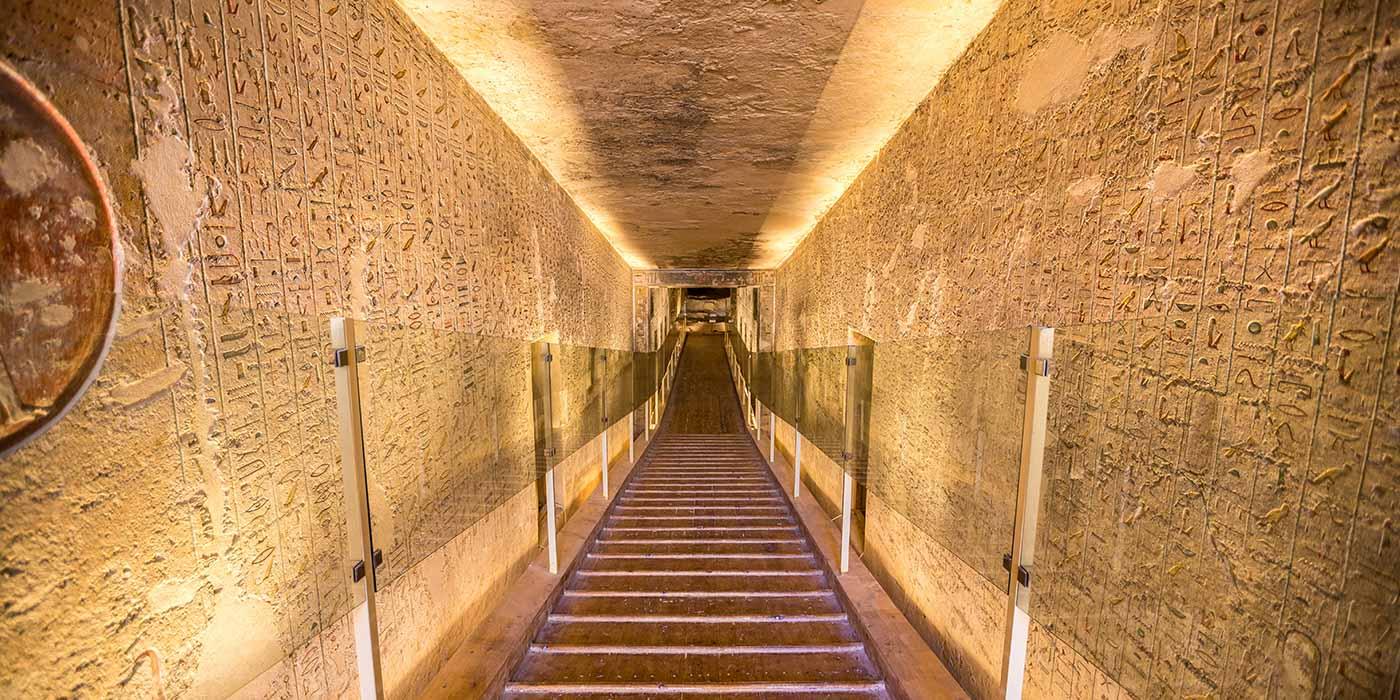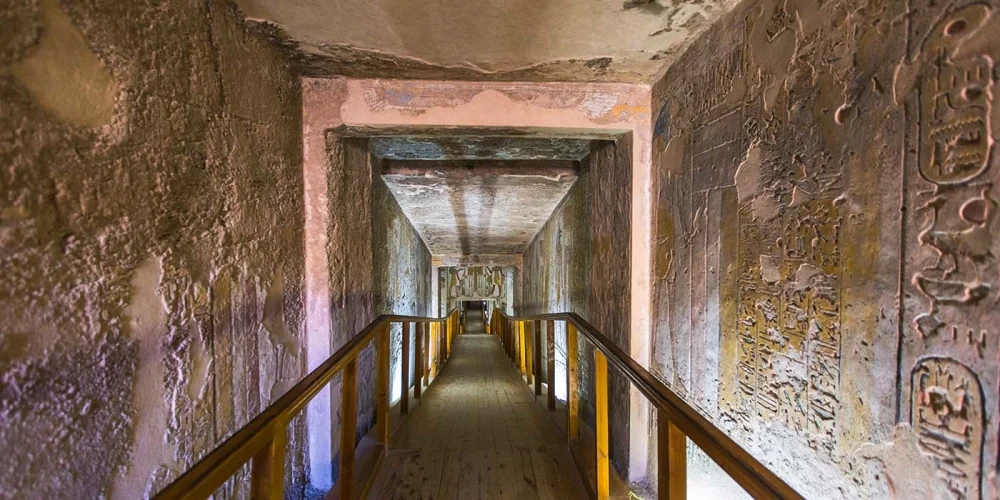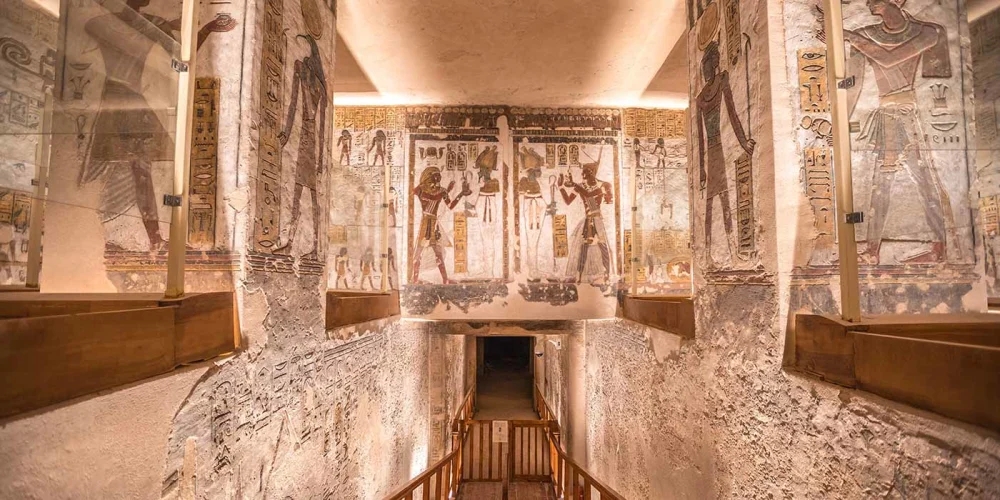
The Valley of the Kings, an awe-inspiring necropolis nestled in the heart of ancient Egypt, stands as a testament to the grandeur and mystery of one of the world's most fascinating civilizations.
This vast burial ground, located on the west bank of the Nile River near Luxor, served as the final resting place for pharaohs and powerful nobles of the New Kingdom period (1550-1070 BCE). The valley's name in Arabic, "Wadi el-Muluk," translates to "Valley of the Kings," reflecting its royal significance.
For nearly 500 years, this secluded valley became the chosen site for elaborate tombs, replacing the earlier tradition of pyramid burials. The shift to this hidden location was a strategic move by the ancient Egyptians to protect their rulers' remains and treasures from tomb robbers who had plagued the more visible pyramid complexes.
The Valley of the Kings houses 63 known tombs, ranging from simple pits to elaborate corridors adorned with vibrant artwork and hieroglyphics.
The discovery and excavation of these tombs have provided archaeologists and historians with invaluable insights into ancient Egyptian culture, religious beliefs, and funerary practices.
Each tomb tells a unique story, offering glimpses into the lives and afterlife preparations of Egypt's most powerful individuals. The Valley of the Kings continues to captivate researchers and visitors alike, serving as a window into a bygone era of human civilization.

The Valley of the Kings holds immense historical importance, not only for Egypt but for the entire world. It represents a crucial period in ancient Egyptian history, spanning from the 18th to the 20th Dynasties of the New Kingdom.
During this time, Egypt reached the zenith of its power and influence, extending its reach far beyond its borders and leaving an indelible mark on the ancient world.
The tombs within the valley provide a wealth of information about ancient Egyptian society, religious beliefs, and artistic traditions. The intricate wall paintings and reliefs depict scenes from Egyptian mythology, daily life, and the journey of the pharaoh through the afterlife.
These artistic treasures offer invaluable insights into the complex spiritual world of the ancient Egyptians and their understanding of life, death, and rebirth.
Furthermore, the Valley of the Kings has played a significant role in the development of modern Egyptology. The discovery of Tutankhamun's tomb in 1922 by Howard Carter not only captured the world's imagination but also revolutionized archaeological practices and our understanding of ancient Egyptian culture.
The meticulous excavation and documentation of this and other tombs have set new standards for archaeological research and conservation efforts worldwide.

The Valley of the Kings is situated on the west bank of the Nile River, opposite the ancient city of Thebes (modern-day Luxor) in Upper Egypt. This location was chosen deliberately by the ancient Egyptians for its symbolic and practical significance.
The west bank of the Nile was associated with the setting sun and the realm of the dead in Egyptian mythology, making it an appropriate site for royal burials.
Geographically, the valley is nestled within the Theban Hills, a range of limestone cliffs that form a natural amphitheater. The main valley, known as the East Valley, contains most of the known royal tombs.
A smaller West Valley, located nearby, houses additional tombs and was used during certain periods of ancient Egyptian history.
This harsh environment contributed to the preservation of the tombs and their contents over millennia. The dry climate and relative isolation helped protect the burial chambers from moisture and extensive human interference, although many tombs were still looted in antiquity.
The Valley of the Kings served as the final resting place for numerous pharaohs and high-ranking nobles. Some of the most renowned rulers interred in this sacred necropolis include:
These pharaohs, along with many others, left behind tombs that continue to fascinate archaeologists and visitors alike. Each burial chamber offers unique insights into the ruler's life, reign, and the artistic and architectural styles of their respective eras.
The discovery of Tutankhamun's tomb (KV62) by Howard Carter in 1922 stands as one of the most significant archaeological finds of the 20th century. The tomb's near-intact state and the wealth of artifacts it contained revolutionized our understanding of ancient Egyptian royal burials. Some of the remarkable items found in Tutankhamun's tomb include:
However, Tutankhamun's tomb is not the only significant discovery in the Valley of the Kings. Other notable finds include:
These discoveries have not only enriched our historical knowledge but have also contributed significantly to the field of Egyptology, inspiring new research methods and conservation techniques.
The tombs in the Valley of the Kings showcase the pinnacle of ancient Egyptian funerary architecture and art. The design and decoration of these royal sepulchers evolved over time, reflecting changes in religious beliefs and artistic styles. Generally, the tombs follow a similar layout:
The walls and ceilings of these chambers are adorned with intricate paintings and reliefs that serve both decorative and functional purposes. These artworks depict:
The artistic techniques employed in these tombs are remarkable, considering the challenging working conditions in dark, underground chambers. Artists used a variety of pigments to create vibrant colors that have endured for millennia.
The level of detail and symbolism in these paintings provides invaluable insights into ancient Egyptian religious beliefs and artistic conventions.
Architecturally, the tombs demonstrate the ancient Egyptians' mastery of engineering and construction. The careful planning and execution required to create these vast underground complexes, often cut deep into solid limestone, is a testament to their technical skill and ingenuity.
The preservation of the Valley of the Kings poses significant challenges for archaeologists and conservationists. The tombs face threats from both natural and human sources, including:
To address these challenges, various preservation efforts have been implemented:
Despite these efforts, the delicate balance between preservation and accessibility remains a constant challenge. Authorities must continually adapt their strategies to ensure the long-term survival of these irreplaceable historical treasures while still allowing for scientific study and public appreciation.
For those fortunate enough to visit the Valley of the Kings, the experience is truly unforgettable. Here's a guide to help plan your visit:
Remember to respect the site's rules and regulations, which are in place to protect these invaluable historical treasures for future generations.
Ready to embark on your own journey through ancient Egypt? Book your tour to the Valley of the Kings today and walk in the footsteps of pharaohs. Discover the mysteries and marvels of this extraordinary necropolis firsthand!
Despite centuries of study, the Valley of the Kings continues to hold many secrets and unanswered questions. Some of the enduring mysteries include:
These ongoing mysteries continue to fuel archaeological research and capture the imagination of both scholars and the public. Each new discovery or technological advancement brings the possibility of shedding light on these ancient enigmas.
The Valley of the Kings has left an indelible mark on popular culture, inspiring countless books, films, and artistic works. Its mystique and historical significance have made it a popular subject in various media:
This cultural impact extends beyond entertainment, often serving as a gateway for public interest in Egyptology and ancient history. The valley's portrayal in media has contributed to its status as one of the world's most recognizable archaeological sites, drawing millions of visitors each year.
The potential for future discoveries in the Valley of the Kings continues to excite archaeologists and history enthusiasts alike. Several areas of ongoing and potential research include:
The possibility of finding another intact royal tomb, like that of Tutankhamun, remains a tantalizing prospect. However, even smaller discoveries can significantly enhance our understanding of ancient Egyptian culture, technology, and history.
The Valley of the Kings stands as a monumental testament to the ingenuity, artistry, and spiritual beliefs of ancient Egypt. For over three millennia, it has captivated the imagination of explorers, scholars, and visitors from around the world. Its tombs and treasures offer a unique window into one of history's most fascinating civilizations, revealing the complex beliefs and practices surrounding death and the afterlife in ancient Egypt.
As we continue to unravel the mysteries of the Valley of the Kings, we not only learn about ancient Egypt but also gain insights into our own humanity. The dedication, skill, and creativity evident in every tomb and artifact inspire us to consider our own legacies and the marks we leave on history.
The Valley of the Kings remains a place where the past comes alive, where ancient whispers echo through time, and where the spirit of discovery continues to thrive. It stands as a bridge between worlds – the world of the living and the dead, the ancient and the modern – inviting us to explore, learn, and wonder at the extraordinary achievements of our ancestors.

© Copyright 2025 Get Egypt Tour. All rights reserved.